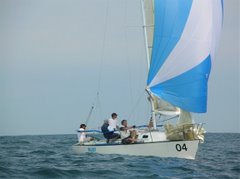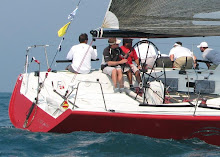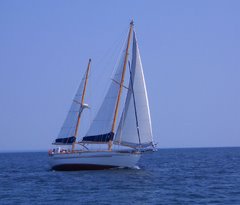
2006 World Team Race World Championships (Sardinia Cup) - Trans Pac 52 Med Style
I have always enjoyed racing box rule boats, IOR One-tons, IOR 50s, ILC 40s, MORC Maxis, it just doesn’t matter, I personally enjoy seeing the advancement of the box rule, so that fact that the TP52s that race in the Med appear to be distant cousins to the first generation of boats matters little to me. In the end the Sardinia Cup was a great opportunity for our team to trial one of the B&C designs built specifically for the Med, and for our owner to see if this is where he wanted to spend his sailing budget.
Trans Pac 52s in the Mediterranean
As I indicated last week, based on our promising performance in the Global Championships, we were invited to compete at the Rolex World Team Race Championships in Sardinia, Italy. Glory sailed a B&C TP52 under sponsorship of WOKITA.com, Gaastra, Balearia and Deporte Galego and I think that most of the team would agree that this boat held little in common with what we had been sailing. The evolution of the TP 52s for the Med began just after the Farr Gen 3 boats came out and while the Mediterranean IMS fleet was looking for the next stable rule (while the IMS 600 raters were quickly designing themselves to their death). Driven by a commitment from many of the principal IMS players including the King of Spain the feet had its first events with roughly 12 boats including Pisco Sour, Orlanda, and Balearia from B&C and Caixa Galicia, Atalanti, Bribon, from Farr and then the US Farr Gen 3 boats represented by Bambakou and Siemens (Sjambok). In the 2006 Sardinia Cup we sailed one of the 2005 B&C designs that were known for their high form stability, very thin keel section and the need to have their bow down to perform well. We struggled acclimating to this package in the short time we had available to get tuned, but it was good to see what designs were where in the design spectrum before looking to select a designer for 2007.
In 2006 the fleet grew to roughly 22 including new designs from B&C, Farr, Brenta, and the series winner (Mutua Madrilena MM) from Rolf Vrolijk. From 2005 to 2006 the fleet evolved dramatically from going fast in a straight line (I am oversimplifying here) to much more focus on holding a line upwind (since the fleet doubled in size) and keel and hull shape changes bore this out. However a strong showing from the 2005 Siemens (Patches – 2006 Globals winner) and continued bursts of speed from the 2005 B&C and Farr designs, it showed that you did not need the newest boat to win races.
It will be interesting to see what happens in 2007 as the level is upped even further than MM pushed it in 2006 and if the fleet can continue its rapid growth with a rumored 25 boats ready for 2007 and nine new teams hitting the water. However, 2007 will be critical year as the fleet appears to be hitting a plateau with key team such as Orlanda (2005), Atalanti (2006) and Rush (2006) appearing not to be returning this summer.
Observation 1: Spars - The standard for many years were two-spreadered Hall spars. Last year we used two different generations of the Hall spars and became quite familiar with tuning it but after attending the Sardinia Cup and looking closely at what was coming out of New Zealand, we had a big decision to make. At the time the 2006 boats were launched, several of the top programs – many of which were built in New Zealand sported three spreaders with minimum tube thickness. Much has been written about this in the press over the last year so I will not go too deep on this point, but the end story was that the top 2 finishers (Mutua MM and Warpath) both used three spreaders last year and a lot was made of this, especially when Warpaths sistership struggled with a two spreader rig (this is the presses observation and not mine). Hall Spars has come out with a new generation spar this year and it will be interesting to see how things play out over the course of the season as several team expecting to be competing for top honors have chosen spars for the US manufacturer. A lot of press was about Southern Spars masts and they indicated last year that in addition to three spreaders being more stable; their rig required less adjustment or tuning over a wider range of conditions. Additionally, with the increase in stability, the three-spreader mast was debated as to being superior due to achieving reduced windage through consequent reduction in mast section size and rigging dimensions despite a numerical increase in spreaders.
Observation 2: Sail inventory – The good the bad and the ugly – we saw all three over the course of the Globals and the Sardinia Cup. In my mind biggest source of evolution through 2006 and into 2007 is the transition between the Masthead Genoa and the Asymmetric A0 – we used our A0 spinnaker very effectively last year on Glory on the Swiftsure Offshore Classic but struggled with the Genoa/A0 combination during the Sardinia Cup distance race. We have been looking very closely at this set up over the last few months and we will need to do some serious testing in April and May if we are going to get it right come race day. One thing that really stood out looking at the sail programs while in Italy was the amount of money invested by several campaigns in proprietary sail designs. In my 30 years sailing and my 14 year sail making career it has always been apparent that there is an established pecking order driven by the amount of money you want to pay for a given service but this is overtly apparent in the TP 52 class where several of the top boats have a dedicated designer (often from AC syndicates) for headsails, another for mains, and another for downwind and reaching sails. At the same time, my observation is, that there are also several of the programs that use “off the shelf” designs, often with more durable membranes and fibers, fewer battens etc. Budget will drive the path that an individual program takes for their sail design and construction. Key in 2007 will be sail limitations and with the maximum sail allowance of only 25 sails allowed this year, designers and program managers will have their work cut out for them as they try to figure out how to stretch 25 sails over all 5 events - especially now that the last 2 venues of the 2007 Med Cup (and 2007 worlds in Sardinia) are slated to be sailed in significantly windier regions than the first 3 events.
Side Note: Sponsorship – everyone on our team was surprised at the level of sponsorship in the Med. What I think stands out the most for me, was the number of Farr 40s changing sponsorship between the Farr 40 European Championships and the Sardinia Cup. Teams were literally tearing 10-20 foot logos off the hulls and replacing them with the next batch of sponsors before the next event. We felt really lucky to be involved with a great group of companies with both WOKITA.Com and Gaastra showing us what could be done sponsor-wise in Europe.
Later this week – Overview of this summer’s sailing and the new boat.




No comments:
Post a Comment